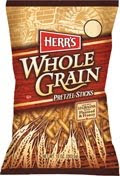Muffins can be a health-conscious person's downfall. Portion sizes have ballooned over the years, and it's not unusual to see a commercial muffin contain over 400 calories. And because you should include some fiber at each meal, a good breakfast means you need a good dose of fiber.
If you're interested in making your own high-fiber breakfast muffins, try these "Reduced-Fat Whole Grain Blueberry Muffins" from Jeanne Jones of the
Cook it Light newspaper column. They're simple, quick and bring you back to the basics about what a muffin should be:
Reduced-Fat Whole Grain Blueberry Muffins
Makes 18 muffins
- 1 1/2 cups whole-wheat pastry flour
- 1 cup quick-cooking oats
- 1 teaspoon baking poweder
- 1/2 teaspoon baking soda
- 1/4 teaspoon salt
- 2 egg whites
- 1/2 cup sugar
- 1/2 cup water
- 1 teaspoon vanilla extract
- 2 tablespoons canola oil
- 3/4 cup unsweetened applesauce
- 1 cup blueberries, fresh or frozen (do not thaw)
TOPPING
- 2 tablespoons sugar
- 1/4 teaspoon cinnamon
Preheat oven to 400 degrees. Spray muffin tins (18 muffins) with nonstick cooking spray and set aside.
Combine the flour, oats, baking powder, bakins soda and salt. Set aside.
In a large bowl, bea tthe egg whites, sugar, water, vanilla, oil and aplesauce. Add the blueberries to the flour mixture and cover the blueberries with flour, which prevents them from sinking to the bottom of the batter. Ad the flour mixture, along with the blueberries, to the egg mixture, and combine with a few strokes, just until moistened.
Fill the muffin cups about 2/3 full. For topping, combine the 2 tablespoons sugar with the cinnamon and sprinkle the top of each muffin.
Bake for 18 to 20 minutes, or until a sharp knife inserted into the center comes out clean.
Each muffin has 10 calories, 2 g fat, 99 mg sodium, 20 g carbohydrate, 2 g protein and 2 g fiber.





































